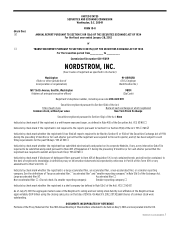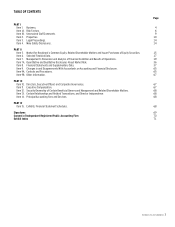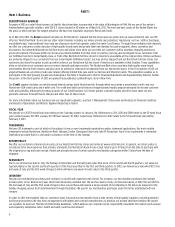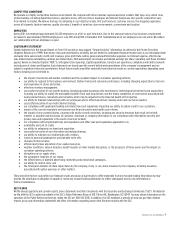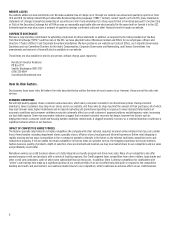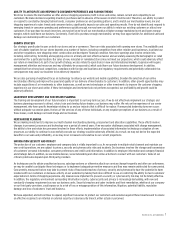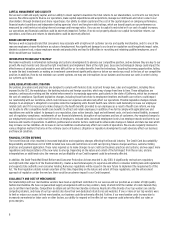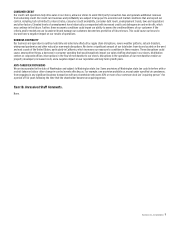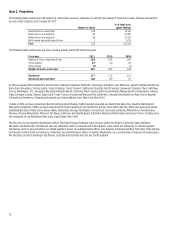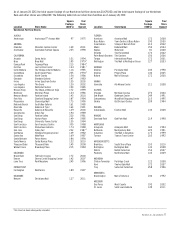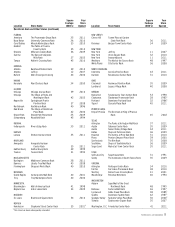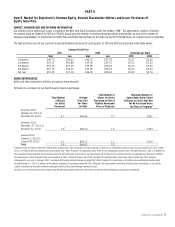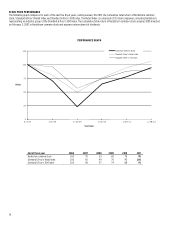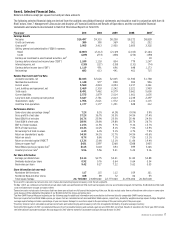Nordstrom 2011 Annual Report Download - page 8
Download and view the complete annual report
Please find page 8 of the 2011 Nordstrom annual report below. You can navigate through the pages in the report by either clicking on the pages listed below, or by using the keyword search tool below to find specific information within the annual report.8
CAPITAL MANAGEMENT AND LIQUIDITY
Our access to debt and equity capital, and our ability to invest capital to maximize the total returns to our shareholders, is critical to our long-term
success. We utilize capital to finance our operations, make capital expenditures and acquisitions, manage our debt levels and return value to our
shareholders through dividends and share repurchases. Our ability to obtain capital and the cost of the capital depend on company performance,
financial market conditions and independent rating agencies’ short- and long-term debt ratings, which are based largely on our performance as
measured by credit metrics including interest coverage and leverage ratios. If our access to capital is restricted or if our cost of capital increases,
our operations and financial condition could be adversely impacted. Further, if we do not properly allocate our capital to maximize returns, our
operations, cash flows and returns to shareholders could be adversely affected.
BRAND AND REPUTATION
We have a well-recognized brand that consumers may associate with a high level of customer service and quality merchandise, and it is one of the
reasons employees choose Nordstrom as a place of employment. Any significant damage to our brand or reputation could negatively impact sales,
diminish customer trust, reduce employee morale and productivity and lead to difficulties in recruiting and retaining qualified employees, any of
which would harm our business.
INFORMATION TECHNOLOGY STRATEGY
We make investments in information technology and systems developments to advance our competitive position, and we believe they are key to our
growth. We must monitor and choose the right investments and implement them at the right pace. Excessive technological change could impact the
effectiveness of adoption, and could make it more difficult for us to realize benefits from the technology. Targeting the wrong opportunities, failing
to make the best investments or making an investment commitment significantly above or below our needs may result in the loss of our competitive
position. In addition, if we do not maintain our current systems, we may see interruptions to our business and increase our costs in order to bring
our systems up to date.
LAWS, REGULATIONS AND LITIGATION
Our policies, procedures and practices are designed to comply with federal, state, local and foreign laws, rules and regulations, including those
imposed by the SEC, the marketplace, the banking industry and foreign countries, which may change from time to time. These obligations are
complex, continuously evolving and the related enforcement is increasingly aggressive, particularly in the state of California, which has increased
the cost of compliance. Significant legislative changes, including those that relate to employment matters and health care reform, could impact
our relationship with our workforce, which could increase our expenses and adversely affect our operations. Possible legislative changes include
changes to an employer’s obligation to recognize collective bargaining units. Recent health care reform could materially increase our employee-
related costs and if it is necessary to make changes to the health benefits provided to our employees as a result of health care reform, we may
not be able to offer competitive health care benefits to attract and retain employees. In addition, if we fail to comply with applicable laws and
regulations we could be subject to damage to our reputation, class action lawsuits, legal and settlement costs, civil and criminal liability, increased
cost of regulatory compliance, restatements of our financial statements, disruption of our business and loss of customers. Any required changes to
our employment practices could result in the loss of employees, reduced sales, increased employment costs, low employee morale and harm to our
business and results of operations. In addition, political and economic factors could lead to unfavorable changes in federal and state tax laws which
may increase our tax liabilities. An increase in our tax liabilities could adversely affect our results of operations. We are also regularly involved in
various litigation matters that arise in the ordinary course of business. Litigation or regulatory developments could adversely affect our business
and financial condition.
FINANCIAL SYSTEM REFORMS
The recent financial crisis resulted in increased legislative and regulatory changes affecting the financial industry. The Credit Card Accountability
Responsibility and Disclosure Act of 2009 included new rules and restrictions on credit card pricing, finance charges and fees, customer billing
practices and payment application. These rules required us to make changes to our credit card business practices and systems, and we expect more
regulations and interpretations of the new rules to emerge. Depending on the nature and extent of the full impact from these rules, and any
interpretations or additional rules, the revenues and profitability of our Credit segment could be adversely affected.
In addition, the Dodd-Frank Wall Street Reform and Consumer Protection Act was enacted in July 2010. It significantly restructures regulatory
oversight and other aspects of the financial industry, creates a new federal agency to supervise and enforce consumer lending laws and regulations
and expands state authority over consumer lending. Numerous regulations will be issued in the near future to implement the requirements of this
Act. The final regulatory details remain uncertain at this time. Depending on the nature and extent of these regulations, and the enforcement
approach of regulators under the new law, there could be an adverse impact to our Credit segment.
AVAILABILITY AND COST OF MERCHANDISE
Our relationships with our merchandise vendors have been a significant contributor to our success and our position as a retailer of high-quality
fashion merchandise. We have no guaranteed supply arrangements with our key vendors, many of whom limit the number of retail channels they
use to sell their merchandise. Competition to obtain and sell this merchandise is intense. Nearly all of the brands of our top vendors are sold by
competing retailers, and many of our top vendors also have their own dedicated retail stores and websites. If one or more of our top vendors were
to limit or reduce our access to their merchandise, our business could be adversely affected. Further, if our merchandise costs increase due to
increased raw material or labor costs or other factors, our ability to respond or the effect of our response could adversely affect our sales or
gross margins.

